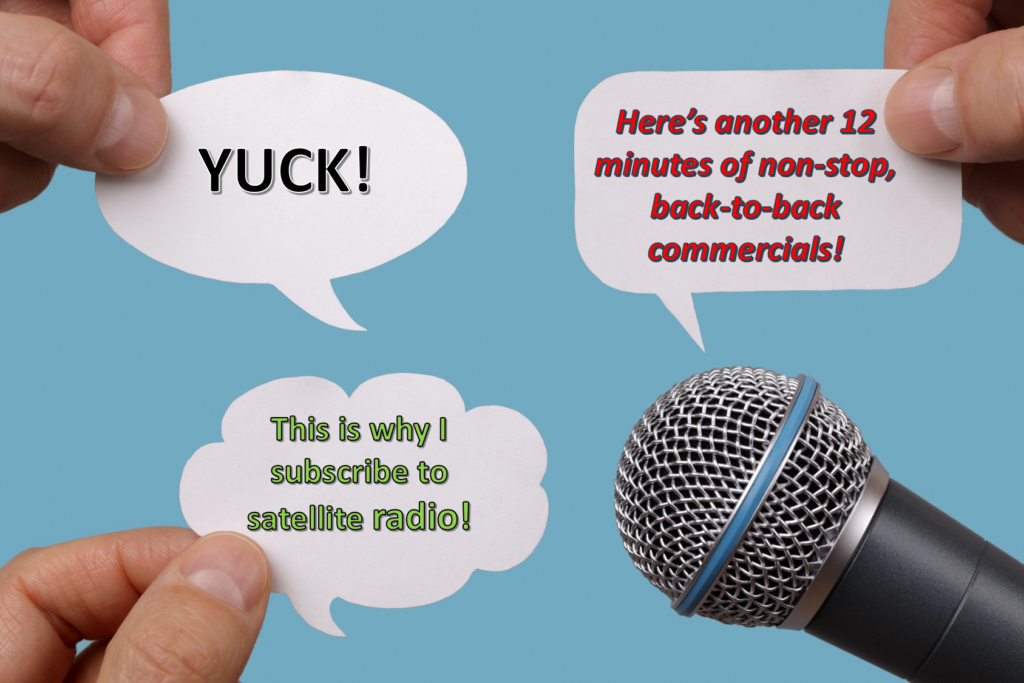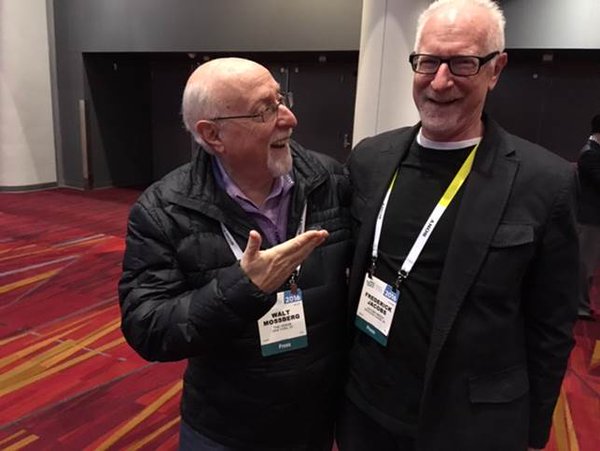
Welcome to another edition of #TBT here on the JacoBLOG. For today’s retro post, it’s an entry from eight years ago that (sadly) still has relevance today. In fact, it’s a sad commentary that radio’s quality of advertising – especially its local spots – might actually be getting worse.
And yet, no one seems to care. The medium of commercial radio depends on advertising for its sustainability. Yet, so many commercials are substandard at best.
At CES earlier this month, we were struck by how many tech companies are utilizing AI and other digital tools to craft better quality ads and an improved advertising experience. From LG to SK, new technology is being cleverly used to produce better user experiences.
Will AI elevate the quality of advertising on the broadcast radio airwaves? So many have a palpable fear of artificial intelligence they may not realize the robots may be capable of producing better ads that are faster, cheaper, and possibly more effective.
Radio pros like long-time Katz executive Bob McCurdy and former B101/Philadelphia owner Jerry Lee (both mentioned in today’s post) were the loudest and most credible of the voices arguing for better quality radio ads. Back in 2017 when this post was first published both were in positions of prominence in the industry. Sadly, McCurdy passed away in 2020, while Lee’s iconic B101 was acquired by Audacy (nee Entercom) in 2018.
Who advocates for better commercial production on broadcast radio today? You can cut the silence with a razor blade. – FJ
January 2017
The era of the PPM ratings methodology has taught programmers about the value of minute-by-minute programming. Meters can migrate on a dime, reacting to everything from a rambling DJ to poor encoding to a weak-testing song.
Yet, why does everyone seemingly ignore the 25 minutes of commercials they run every hour?
A couple weeks ago, ad copywriter savant, Kevin Gunn, from Beasley’s WMMR, provided a template for writing better radio copy. And down the street in Philly, Jerry Lee has been on a one-man mission for years to cajole and beg radio to raise its creative commercial game. From better results to longer listening spans, there are compelling reasons for radio to invest in its stopset strategy.
And now there’s one more reason:
Web advertising is abysmal – and getting worse.
That reality came into focus last week when Walt Mossberg, tech guru from Recode, wrote a pointed story about the web advertising experience:
“Lousy ads are ruining the online experience.”
Mossberg recounted his bumpy online experience while trying to simply watch an NFL playoff game replay. It’s an experience that we all share every time we’re surfing around the web. It’s a lot of things: forced ads that automatically run, long pre-rolls, incessant buffering, trying to fool us into clicking the wrong link. Mossberg’s point is that web advertising has become a minefield.
How many of us have simply given up by x-ing out a web page because it was simply unnavigable? It seems like every time you click on “The 10 Least Expensive Cities In America” or “The 12 Colleges With The Best ROI,” the experience is so fraught with speed bumps and glitches that you just throw in the towel – or mouse.
Mossberg cites the recent move by Ev Williams, CEO of Medium, who recently canned his entire ad sales team. And while Williams may end up moving to a subscription model to eliminate the manic, cacophonous, and intrusive web experience, the fact is that when it comes to advertising, the Internet is broken.
That’s summed up by Scott Cunningham, SVP Technology and Ad Operations for the Interactive Advertising Bureau:
“We lost track of the user experience. Looking back now, our scraping of dimes may have cost us dollars in consumer loyalty.”
Doesn’t that statement ring true in the radio business, too? As big radio companies fell deeper into debt, programmatic and remnant ads have become the norm, driving the commercial experience down the drain, making stopsets virtually unlistenable. The quest for revenue – any revenue – has created the worst possible environment for radio’s two biggest constituencies – advertisers and listeners.

There are so many different players intertwined together on the web that Mossberg all but suggests that aside from subscription models, the experience may not be fixable. And given that so many of radio’s traditional spenders have moved to digital spaces, that’s a story that sales departments should be sharing with clients. When the IAB raises doubts about the efficacy of online advertising, you’ve got a problem on your hands.
Radio, as an industry, may actually be in a position to take control of its own substandard advertising experience. Unlike the catacomb-like nature of the Internet, the radio advertising ecosystem is smaller, tighter, and more like a small community than a global morass of vendors, third party players, and scam artists all trying to game the system.
Initiatives from the RAB and pioneers like Jerry Lee and Bob McCurdy could actually improve the on-air advertising experience, at least a few times an hour. If that turned into more sales success stories and improved listening duration, isn’t that an initiative worth pursuing?
In recent years, radio has had its hands full competing with Internet ad models.
By improving its advertising experience, its old-school solution could become fashionable again.

P.S. Condolences to the family, friends, and many colleagues of radio sales pro Gary Krantz whose passing was announced late yesterday. Our company – especially Paul and me – had a number of encounters – better put, adventures – with Gary over many years.
He was a consummate “schlepper,” always pumped up about his latest project, many of which ran the gamut over the decades. Gary’s enthusiasm was strictly “old school,” but highly contagious. He could get fired up about pretty much any product, service, or concept and explain to you why you needed it…NOW!
At a time when great sellers are rare and many organizations struggle with motivating them, Gary’s irrepressible charm and belief in the value of the products, programming, and people he represented was enduring.
May his memory be a blessing. – FJ
- A 2020 Lesson?It Could All Be Gone In A Flash - April 24, 2025
- How AI Can Give Radio Personalities More…PERSONALITY - April 23, 2025
- Can Radio Afford To Miss The Short Videos Boat? - April 22, 2025





There is no technology in the world, including AI, that can improve the quality of local spots. The only solution is to educate and train both sellers and clients to allow creative talent to do their job. I have been on a creative crusade since 2001 evangelizing that exact message. I assure you, as long as clients disrupt and micromanage the creative process, which is a result of sellers mismanaging expectations and enabling clients to do so, listeners will continue to be insulted with stop set full of uninspiring ads.
I wholeheartedly agree. I have presented this same position for over 30 years.
The “Creative Talent” was laid off in the last round of budget cuts..
We’ve taken to heart that radio ads suck! And both of my stations have put an emphasis on great production. We employ dozens of voices from around the country, paying them for voice work. But it starts at the copywriting phase and we’ve been elevated by the work of Paul Ciliano, who came from programming shifted into sales at KGAY/KMEE. His spots are sometimes theatre of the mind, but also make the call to action apparent and really stand out. It’s prompted all of the other sales people to do better – and to learn from him. As an LGBTQ station, we sometimes get a little edgy with our commercials. But rarely do we receive a complaint — unless it’s a Chik-fil-A commercial (they have a homophobic reputation and when one spot accidentally played from network inventory, our listeners immediately let us know). That means they pay attention to our spots.
We’re considering AI generated production utilizing Rumple’s new technology, and it will likely happen. But we’ll still put an emphasis on good old fashioned copywriting.
Radio advertising has degraded consistently over the past several years. Automated log generation, poor production, and an absolute lack of quality control are evident. It’s not always the fault of radio stations.
Radio companies push out absolute crap on a “must run” order as a national buy, Barter programs desperate for cash add more awful ads. On top of that, advertisers are sold on “volume discounts” that end with the same ad running twice a stopset, or a combination of national and regional buys end up with so much repetition that the same ad too frequently runs back-to-back. I understand the repetition gains attention, but in this case, it’s negative attention. It may make the advertiser memorable, but it turns off listeners for the radio station.
Production departments are radio stations are a shadow of their former selves, even if they exist. Hubbing is the norm, with regional “production centers” replacing local talent. It’s a win if they get the name of the advertiser and/or street right. Whether the tone is right, or even the info, is another question.
Maybe AI will produce several ads instead of one, so at least you won’t hear the same ad back-to-back. Maybe it can schedule commercials according to rules that prevent back-to-back ads, or ads from competing advertisers from running back-to-back. The current automated systems don’t seem to do that on OTA stations, let alone on the stream. Streaming is infinitely worse, including dead air and insipid filler that doesn’t reflect the content of the station at all.
It’s true. None of the above serves advertisers or listeners well. It devalues both the product and the ad. Radio needs to demand better, or it will continue to kill itself via the death of another thousand cuts. You can’t stop the bleeding by continually cutting.
I was so proud of our spot breaks! Paul Mollenkamp was our brilliant copywriter. Scott Morello, Justin Weiner and myself all collaborated and produced. Four full time production people at KISS 108 in Boston. It was great while it lasted. After my team was dismantled, the station didn’t make its budget. We had worked closely with sales to help our station greatly exceed budget every year. But the new corporate owners never associated the expense of our 4 full time salaries with the millions of dollars in revenue we directly generated.
It’s 2025 and I doubt that many, if any, of the current decision makers today were around around during radio’s heydays. Nor do they recognize the value of investing in staff, instead treating staff as replaceable at best, and positions to be eliminated at worst (in the interest of saving money).
So, everything is done the cheapest way possible. And it shows. Uninspired cut and paste copy; minimal production and whatever voice happens to be available.
The blame is at the top: management has no vision, understanding, or budget to do anymore than the minimum. And, staff will reflect the values and attitudes of management.
Your second paragraph. When the only/best way is the cheapest way possible, your output will suffer. GIGO. Thanks, Phil.
One production guy; five stations to fill; ads, imaging and public affairs shows to record; and only so many numbers on the clock. Any station that cuts out personnel from the Creative and Production ranks may as well just set fire to the transmitter site now.
FWIW, WMBG Williamsburg won 1st place Small Market Statewide for Best Commercial last June by the VA Association of Broadcasters, and with a part-time Creatives crew. It can be done.
Alan, “economy of scale” hits the wall when the quality of the product suffers. As you point out, one prod person for a cluster of stations isn’t going to work. (And when happens when he/she wants to take a much-needed vacation?) And congrats on that VAB win.
In the Asheville market, I hear ads for CALL DAD AC & HEATING. They are smart homespun stories that change weekly. The son tells a “slice of life” story and ties it into how the family always called on Dad to fix the issue or lend experience to guide the family. I learned recently the spots are crafted by an agency. This kind of storytelling in ads blends radio-like content with a commercial purpose so you want to listen to the ad and not turn the dial. They are very well done,.
I have noticed that not only are the breaks 8 minutes long, but less than a third of them are local businesses. Most of them are national ad buys that the corporate conglomerates are forcing on their local stations. I just don’t listen to radio anymore, and I work in the business
My mentor, Jim Shelton at WIBC Indianapolis, once told me that in radio you need to know HOW to sell a product over the air using only your voice! He was a top rated DJ, who later became a top billing sales rep. I just produced a video of great Philadelphia air talent from 1993 and back then you’d be amazed at the amount of LIVE READS on the air. In every case the talent would read the spot in a conversational tone that did NOT sound like they were reading a script. Warm and friendly was the key. A client would always pay a LOT more if Paul Harvey read the spot. We need more people like him to really make radio ads sound compelling rather than a tune-out factor.
Those live reads were powerful “back in the day.” I’m thinnking there were a lot fewer of them as well, helping the really good reads stand out. I get the point though – many of today’s live reads are rushed – not warm and friendly. It doesn’t matter whether the copy is good if the read sounds like a jock going through the motions.
Art, totally agree. More emphasis needs to be put on live reads.